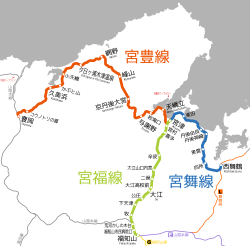 Miyafuku Line (宮福線), Miyamai Line (宮舞線) and Miyatoyo Line (宮豊線) | |
| Overview | |
|---|---|
| Headquarters | Miyazu, Kyoto |
| Dates of operation | 2015 – |
| Predecessor | Kitakinki Tango Railway |
| Technical | |
| Track gauge | 1,067 mm |
| Length | 114.0 km |
| Other | |
| Website | trains |
The Kyoto Tango Railway (京都丹後鉄道, Kyōto Tango Tetsudō), or Tantetsu (丹鉄), is a railway system in Kyoto Prefecture and Hyōgo Prefecture, Japan operated by Willer Trains Inc. headquartered in Miyazu, Kyoto.[1]
Company
The operating company Willer Trains Inc. is a subsidiary of Willer Alliance Inc. Willer Trains is the first railway company in the Willer group, which is primarily operating in the industry of bus services.[1][2]
Lines

The Kyoto Tango Railway consists of the following three lines:[1]
- Miyafuku Line
- Miyamai Line (Brand name of the Miyazu Line between Nishi-Maizuru and Miyazu)
- Miyatoyo Line (Brand name of the Miyazu Line between Miyazu and Toyooka)
The operation as the Kyoto Tango Railway began on April 1, 2015 succeeding the train operation function of the Kitakinki Tango Railway, which still owns the tracks and rolling stocks of the railway.[1] The railway provides access to Amanohashidate Station, where Amanohashidate, one of Japan's three scenic views, is located.
Special trains
The company operates one restaurant train called "KURO-MATSU", as well as two sightseeing trains called "AKA-MATSU" and "AO-MATSU".[3]
References
- ^ a b c d 小佐野カゲトシ (April 1, 2015). "ウィラー初の鉄道路線「京都丹後鉄道」スタート…北近畿タンゴ鉄道の運行引き継ぐ". Response (in Japanese). Retrieved April 4, 2015.
- ^ 大坂 直樹 (June 22, 2014). "高速バスの"革命児"が挑む、赤字鉄道の再生". Toyokeizai (in Japanese). Retrieved April 4, 2015.
- ^ "Kyoto Tango Railway KURO-MATSU Train". Retrieved December 13, 2020.
